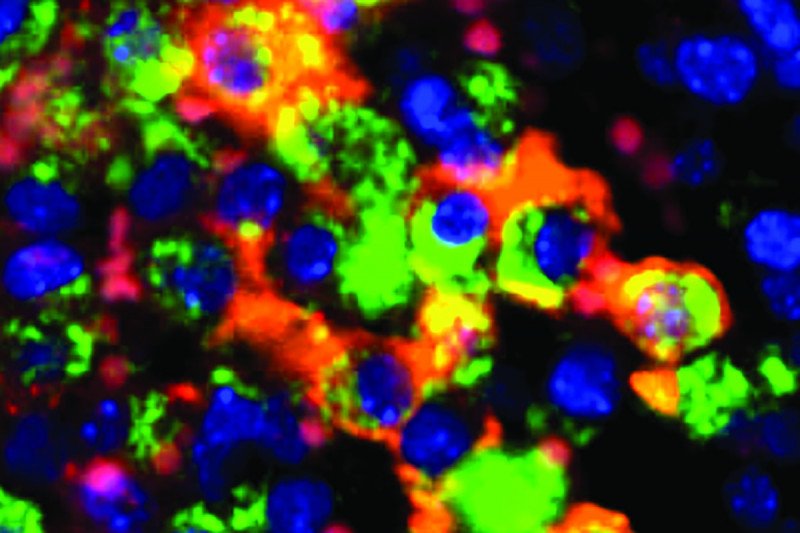
This image shows iron-filled macrophages from a breast cancer tumor. Cell nuclei are blue; the other colors reflect different types of macrophages present in the tissue.
Scientists at Memorial Sloan Kettering have developed an imaging technique that allows them to see individual immune cells in tumors. A type of magnetic resonance imaging (MRI), the technique takes advantage of the way that immune cells called macrophages concentrate iron. Iron creates a distinct pattern in an MRI scan that can be analyzed with special software to determine the precise location and number of these cells in tumors.
“We call it innate metabolic imaging of cellular systems,” says Avigdor Leftin, a postdoctoral fellow in medical physics at the Sloan Kettering Institute who developed the approach with his adviser, Jason Koutcher, Chief of the Imaging and Spectroscopic Physics Service at MSK. “Basically, we combine standard MRI methods with some very simple signal processing, and voilà, we have this beautiful cellular imaging method that relies on the innate iron metabolism of cells.”
The technique offers a valuable, noninvasive way for researchers and doctors to obtain a “virtual biopsy” of an important immune cell involved in cancer. It could one day help doctors tailor treatments to particular patients and even monitor the effectiveness of a treatment in real time.
Metal Detector

Seeing is believing: The top row shows iron detected through FeMRI. The bottom row shows the same tissues with iron stained blue.
MRI uses radio waves aimed at water in the body, combined with a magnetic field, to visualize different tissues. Depending on the chemical composition of those tissues, the radio waves bounce off the water in characteristic ways. When iron is near a water molecule, it prevents the radio signal from leaving the area, creating a kind of black hole.
Doctors typically give people receiving an MRI a contrast agent beforehand to heighten the differences between tissues. Many contrast agents contain iron. Macrophages tend to gobble up these agents — their name means “big eaters” in Greek — so they are common MRI targets. But the agents can be toxic and may also change the biological properties of the macrophages.
The new technique, dubbed FeMRI (Fe is the chemical symbol for iron), doesn’t require a contrast agent to produce useful images. Instead it provides a biopsylike score of macrophages that relies on the cells’ natural iron content. Detecting the higher iron content of the macrophages is a dead giveaway of the cells’ location in a tissue.
Mining Iron for Cancer Therapy
Macrophages are useful to measure for several reasons. They are among the body’s first line of defense against invading pathogens, and they help recycle important elements, such as iron from blood. Macrophages also play an important role in cancer: They can support tumor growth and can even reduce the effectiveness of certain cancer therapies.
Being able to quantify macrophages and track their movements over time could give doctors insights into how a particular treatment is or isn’t working. It’s especially relevant to newer immunotherapies, which use the immune system to fight cancer.
“Macrophages are really critical in the whole immune therapy mechanism,” Dr. Leftin points out. “A lot of the press we see these days is about T cells. But one way that T cells actually work is by communicating with macrophages. So knowing where these macrophages are is very valuable.”
Broad Uses in Medicine
Dr. Leftin and his colleagues demonstrated the feasibility of the iron-based approach by imaging macrophages in metastatic breast cancer and prostate cancer. Macrophages in tumors are associated with worse prognosis in many cancers, not just these.
He says FeMRI could also find uses in imaging nanoparticles, characterizing iron-related blood disorders, such as anemia, and even detecting the iron deposits in the brain that are associated with many neurodegenerative diseases.
Although the technology is not yet being used as part of patient care at MSK, there are few technical hurdles standing in the way. “The imaging can be done anytime because the basic capability is already part of every MRI scanner in the world,” Dr. Leftin notes.
MSK has secured a patent for the technology and is currently looking to develop it further by partnering with software and MRI companies.

